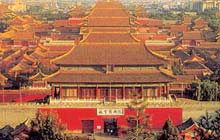
 Yong Le (r. 1402-1424), the third Ming Emperor, moved the capital of China back to Beijing in order to fortify Northern China against the continuing threat of the bellicose Mongols. It was he that razed the palaces of Kublai Khan, built over a century earlier, to redesign the Forbidden and Imperial Cities in their new location slightly to the south-east. Since then, with only minor interruptions, the Forbidden City has served as an exclusive seat of government. Just as commoners were not allowed to penetrate the Forbidden City under the Ming and Qing dynasties, today most citizens and foreigners are not permitted into the government conclave in Zhongnanhai.
Yong Le (r. 1402-1424), the third Ming Emperor, moved the capital of China back to Beijing in order to fortify Northern China against the continuing threat of the bellicose Mongols. It was he that razed the palaces of Kublai Khan, built over a century earlier, to redesign the Forbidden and Imperial Cities in their new location slightly to the south-east. Since then, with only minor interruptions, the Forbidden City has served as an exclusive seat of government. Just as commoners were not allowed to penetrate the Forbidden City under the Ming and Qing dynasties, today most citizens and foreigners are not permitted into the government conclave in Zhongnanhai.
The rule of the Emperor was legitimized through a code known as the Mandate of Heaven, which presumed that the Emperor owed his status to Heaven. When an Emperor and dynasty were deposed successfully, this was interpreted as being in line with a new will of heaven, for otherwise it would not have been allowed to occur. In this way, the exclusionary and privileged life of the Emperor behind the walls of the luxurious Forbidden City was legitimized. So it is that in the Forbidden City there are reputed to be 9,999.5 rooms; half a room short of 10,000 which, it is said, is what the original Jade Emperor possesses in his Heavenly Palace.
One of the major political developments under the Ming dynasty was the Emperor's greater involvement in the administration of China. Rather than delegate control to the Ministries, the Ming Emperors developed a complex Imperial bureaucracy, comprised mainly of eunuchs, to supervise the machinations of government. As a result, to accommodate this vast, internal administration, the Forbidden Palace had to be constructed on a hitherto unprecedented scale.
The architecture and design of the Forbidden City along a North South axis reflect its dual purpose of providing a suitable environment for both Imperial government and Imperial life. To the South the buildings are grandiose and formal, built on a scale to impress visiting dignitaries. As you wander further north into the Emperor's personal quarters, you will see smaller structures, reflecting the greater intimacy of the Emperor's private life. The division between the private and public quarters takes place about the Gate of Celestial Purity. To its south are the three formal reception halls of Supreme Harmony, Central Harmony and Preserved Harmony. To its north is the Empress's Palace of Celestial Purity, the Emperor's Palace of Terrestrial Tranquillity and between them, the Hall of Terrestrial and Celestial Union.
Thus, in Imperial times, seniority translated into geography: the more senior you were, the further north you were invited to advance. Whereas a visiting ambassador might only be allowed as far as the Hall of Supreme Harmony, the tallest building in Imperial Beijing, a King might be invited further north into the Hall of Preserved Harmony.